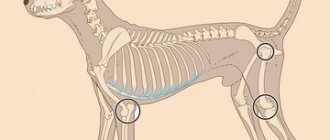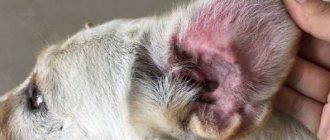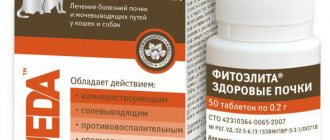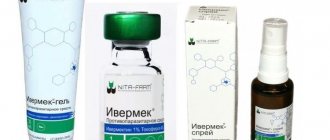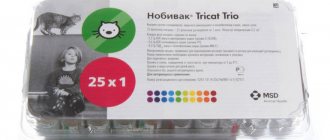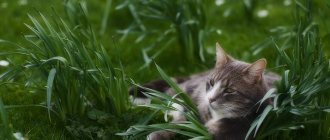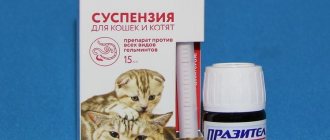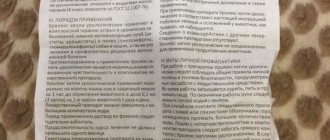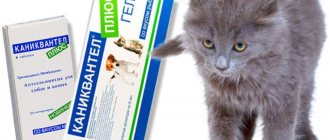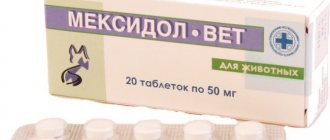Composition of the innovative drug and release form
Artroglycan can be found at any veterinary pharmacy or purchased online.
The drug is available in slightly grayish tablets. The packaging of Artroglycan is a tube jar or pack. They are decorated in bright yellow colors. The pack contains 30 tablets. They are placed 10 on 3 blisters. The plastic tube contains 300 tablets. The preparation is manufactured in St. Petersburg. Each package also contains instructions for using the drug Artroglycan. shutterstock
Price for 1 pack. varies in the range of 160-400 rubles. The cost depends on the volume and supplier. The drug contains a number of active substances:
- Selenomethionine;
- Chondroitin sulfate;
- Vitamin E;
- Calcium gluconate.
The microelements and minerals present in the composition enable Artroglycan to eliminate inflammatory processes by acting locally on cartilage tissue. In addition, the production of joint fluid is activated. Numerous studies have revealed that Artroglycan has a positive effect on many systems of the animal’s body, improving, including the functioning of the heart and liver.
Composition of the drug, how it is produced and how it is stored
The active substances of Artroglycan are:
- -200 mg chondroitin sulfate;
- -10 mg glucosamine hydrochloride;
- -50 mcg selenomethionine;
- -20 mg vitamin E;
- -100 mg calcium gluconate.
The medicine is available in a yellow pack. The package contains 30 tablets, packaged in blister packs of 10 pieces. They also produce a large jar that can hold 300 pills. The tablets are light gray in color.
The drug should be stored in a dry place, protected from sunlight, out of reach of children, at a temperature of 0 to 25 degrees.
The medicine is stored, subject to storage conditions, for 2 years.
The price of the medicine is not high, about 300 rubles per package of 30 tablets. You can buy Artroglycan in most veterinary pharmacies, veterinary stores, as well as in online markets.
How do chondroprotectors work?
Before you start giving your cat Artroglycan, you should understand how it works. To do this, it is enough to understand the structure of cartilage. After all, Artroglycan is prescribed to cats precisely for its maintenance. Healthy pet joints have a smooth surface. It is covered with cartilage tissue that produces a special synovial fluid. Its volume depends entirely on the mobility of the joints. It is necessary to understand that it is this liquid that nourishes the cat’s cartilage, which, if deformed, can become exposed, causing irreversible consequences. Taking Artroglycan has a number of advantages.
- It has a pronounced mechanism for restoring cartilage tissue, analgesic and anti-inflammatory properties.
- It is easily tolerated by cats without causing any side effects. The only exception may be individual intolerance to certain components of the drug.
- In addition to the symptomatic effect, it also has a pathogenetic effect. Artroglycan normalizes metabolism in cartilage, restoring the structure and significantly improving metabolism.
shutterstock However, you should not expect improvements after just a few days of taking Artroglycan and complain about a low-quality drug.
Chondroprotectors act slowly. The cat's condition will improve, but this will take more than one week. It all depends on the complexity of the damage, and therefore the regeneration of cartilage tissue can even take months. In addition, it is necessary to understand that Arthroglycan is effective only at stages 1-2 of joint arthrosis. Therefore, when an aging cat lives in the house, you should systematically consult a veterinarian to prevent the development of the disease. What to pay attention to
If the breeder decides to self-medicate the cat or use the drug for preventive purposes, it is necessary to carefully read the instructions for the drug.
The main thing you should pay special attention to is the dosage and side effects. In addition, you need to know that the use of Artroglycan is prohibited in case of infectious lesions of ligaments and joints
In other cases, the drug is absolutely harmless to the cat and causes allergic reactions extremely rarely. The side effect disappears immediately after stopping Arthroglycan.
Drugs similar in action
The most popular ones are listed below, as well as the differences in composition (if not stated separately, they contain chondroitin, glucosamine, calcium):
- Tsamax - contains seaweed, collagen, ascorbic acid, sulfur, etc. There are no similar elements to Artroglycan. Not recommended for white animals.
- Biolysin Artro also contains vitamins B, D, A, K, minerals, folic acid, collagen, biotin. Selenium is missing. Contains a lower dose of chondroitin. As a rule, it is prescribed for large breeds of dogs. Not recommended for puppies under 6 weeks of age.
- Stop-Arthritis (suspension) – no selenium, calcium, vitamin C, plant extracts.
- Chondrocan is a powder that additionally contains collagen, vitamins A, E, C, magnesium and phosphorus.
- Bonharen is a substance for intravenous or subcutaneous use, the active ingredient is hyaluronic acid. Does not contain common substances with artroglycan. For large breed dogs.
- Stride is a powder that does not contain selenium or calcium, but also contains hyaluronic acid. For large breeds.
- Chondrolone is a substance for the preparation of injections, recommended for large breeds, containing only chondroitin.
- Gelacan - does not have common components with Artroglycan, the active ingredients are hyaluronic acid, glycine, proline. Often used for small breed dogs.
- Chondartron - drops or solution for injection. Contains plant extracts, sulfur, calcium, bee venom, lithium carbonate. Does not contain chondroitin, glucosamine, selenium.
- Pro Bio Omega 2500 is a complex vitamin preparation. Chondroitin is missing. Contains glucosamine, probiotics, polyunsaturated fatty acids, and vitamins. For medium and large breeds.
The use of Artroglycan will help to effectively solve your pet’s health problems if there are appropriate indications, as well as prevent their occurrence. By following the veterinarian's recommendations regarding timing and dosage, the owner will be able to help his pet live an active and long life without experiencing pain or discomfort from movements.
Artroglycan is used in veterinary medicine to strengthen and restore cartilage and connective tissues. The active ingredients of the drug are glucosamine hydrochloride and vitamin E, chondroitin sulfate and selenomethionine, calcium gluconate. Their optimal balance helps to normalize metabolic processes in cartilage tissues, restore damaged cartilage matrices (intercellular substance), and also improves the general condition of the osteoarticular system.
Characteristics of "Artroglycan"
At the beginning of the 21st century, she created a veterinary remedy for the treatment of diseases of bones and joints. Medical tests have proven his competence, especially in relation to representatives of the older age category.
"Artroglycan" is an effective fast-acting chondroprotector. The positive effect the drug has on the liver and cardiovascular system allows it to be classified as a cardio- and hepatoprotector. Used for dogs, cats and decorative rodents.
The action of "Artroglycan" is aimed at older dogs
Pharmacological properties
The abundance of useful components included in the composition classifies the medicine as multifunctional.
Table 1. Main directions of impact
| Improves | Stimulates | Strengthens |
| Synthesis of the main structural element of cartilage and bone tissue | Production of joint fluid | Capillary walls |
| The process of calcium deposition in tissues | Regenerative processes | Joint bursa |
| Joint mobility | Formation of chondroitinsulfuric acid | Heart muscle |
| Production of hyaluronic acid | Suspension of cartilage tissue degeneration | Muscular frame of the skeleton |
Main functions:
- protective;
- pain reliever;
- anti-inflammatory;
- antioxidant.
The product also compensates for the lack of vitamin E, selenium and calcium.
"Artroglycan" contains vitamin E of youth
Composition of the drug
The product has a light yellow powder consistency. Difficult to dissolve in liquid. The composition includes the following components:
Table 2. Composition of "Artroglycan"
| Name | Action |
| Chondroitin sulfate (200 mg) |
|
| Glucosamine hydrochloride (100 mg) |
|
| Vitamin E (20 mg) |
|
| Selenium Methionine (50 mcg) |
|
| Organic form of calcium (10 mg) |
|
The drug contains 10% moisture
Packaging format
The drug is produced in the form of beige tablets. The product is packaged in packages containing 3 blisters of 10 tablets each or in containers of 300 tablets.
In addition to sachets, Artroglycan is available in small jars of 300 tablets
Indications and contraindications
The medicine is aimed at the older age group. It can also be given to young and mature individuals for therapeutic purposes. The only age restriction is puppies. The product is approved for use when the dog reaches 2 months.
Indications for use:
- arthritis;
- arthrosis;
- osteoporosis;
- degenerative joint pathologies;
- joint dysplasia;
- tenosynovitis;
- synovitis;
- inflammatory processes in cartilage;
- spondylosis;
- intervertebral osteochondrosis.
Spondylosis: what is it?
Also used to prevent rickets and calcium deficiency in pregnant bitches.
Veterinarians prohibit the use of the drug in the following situations:
- sensitivity to a certain component;
- bone and joint diseases caused by pathogens in the form of viruses, fungi and bacteria.
In all other situations, there are no contraindications to taking the medication.
The following pathologies have been reported occasionally:
- diarrhea;
- digestive problems;
- itching;
- redness of the skin.
Allergic rashes are one of the possible side effects
If you strictly adhere to the instructions specified in the description of Artroglycan, no negative deviations should occur.
Storage period and conditions
The product should be placed in a dark place, protected from children and animals, with a temperature of 0 to 25°C. The maximum shelf life of opened packaging is 2 years.
Method of use and dosage
The medicine is intended for medical treatment of pets in doses determined by the body weight of the animal. It is advisable to give simultaneously with food. The duration of the therapeutic course is from 3 to 4 weeks. A more precise time frame is set by the veterinarian. It is recommended to use "Artroglycan" during the demi-season period.
If the animal does not swallow it with food, carefully place the tablet in the mouth
For dogs
Admission rules for dogs:
- for animals weighing up to 40 kg - 1 tablet per 10 kg of weight 2 times a day;
- over 40 kg - 4 tablets 2 times a day.
For puppies, ½ tablet twice a day is sufficient.
Instructions for use and dosage
Artroglycan is given in the following doses:
- for dogs weighing less than 40 kg - 1 tablet for every 10 kg of weight twice a day;
- dogs weighing more than 40 kg – 4 capsules, regardless of weight, 2 times a day;
- if the animal weighs less than 10 kg, the tablet is divided into parts.
The course of treatment is determined by the veterinarian individually for each dog. However, it lasts no less than 3-4 weeks and no more than 3 months. Afterwards they take a break, and if necessary, therapy is resumed.
Dogs do not eat the drug themselves. It is introduced by force:
- open the mouth by pressing with two fingers where the jaws close;
- place the tablet on the root of the tongue;
- close their mouth and raise their head;
- stroke the throat and wait until the pet swallows the capsule.
If it is not possible to feed the tablet, it is crushed and mixed into the food, preferably wet. It will not work to give crushed medicine with water from a syringe - the medicine almost does not dissolve.
Drug treatment
Treatment of arthritis in sick cats should be comprehensive and include several areas. The main goal is to stabilize the condition and improve the quality of life of patients. The disease, unfortunately, has no cure, but with good supportive therapy and proper care, remissions will be quite long, and motor activity will be restored almost completely. The following types of therapy are used:
- surgical intervention;
- drug therapy;
- special care;
- rehabilitation measures to maintain a stable condition of the joints;
- therapeutic nutrition and weight correction;
- physiotherapy.
Special care
It consists of creating comfortable living conditions that make life easier and reduce joint pain:
- first of all, this is the creation of a warm, safe place to sleep, away from drafts;
- to make jumping easier, intermediate supports are placed under the elevations;
- purchase litter trays with a low side;
- place inclined surfaces where there are steps;
- comb the fur and trim the claws to make grooming easier for the cat.
Drug therapy and pain relief
Drug therapy consists of prescribing non-steroidal anti-inflammatory drugs. They have significant side effects, so before starting treatment, they determine whether there are severe pathologies of the kidneys and gastrointestinal tract.
Usually the minimum effective dose of drugs is used. Meloxicam is the most suitable drug for cats.
The course of its administration can be unlimited in time.
Assistive therapy and rehabilitation
As an adjuvant therapy, it is common to use supplements based on chondroitin and glucosamine. They help restore worn cartilage, slowing down its destruction.
In addition, cold and warm compresses can be used on the sore joint:
- a cold compress is used in the acute phase with severe inflammation;
- a warm compress is applied after the inflammation is relieved to stabilize the condition.
Medical nutrition
There are specialized foods for cats diagnosed with this disease. They are a therapeutic diet with a high content of omega-3 fatty acids, chondroitin and glucosamine, which restore articular cartilage. Such foods have a limited fat content, which allows you to adjust the animal’s weight, avoiding obesity.
A sick cat is strictly contraindicated from table food that includes too fatty foods with an unlimited amount of salt and seasonings. Natural nutrition should consist of lean meat, dairy products, and a small amount of fish.
Physiotherapeutic treatment
Among the methods of physiotherapy for cats, massage procedures are recommended. The massage should be very light, but persistent, making blood circulation more active. It is necessary to carry out circular massage movements, slowly moving along the limb to the sore joint.
In some cases, acupuncture may be used. It helps relieve spasms and relieve pain.
Should only be carried out by competent specialists with experience in using this method in veterinary medicine. The downside is that it can only be used if the animal is at rest.
In most cases, treatment of joint diseases in cats involves the use of non-steroidal anti-inflammatory drugs (NSAIDs), which not only stop the inflammatory response, but also significantly reduce the intensity of pain.
The main disadvantage of drugs of this type is the impossibility of their long-term use (in this case, the liver and kidneys suffer greatly). To minimize the risk of side effects, the drug must be selected carefully and used with caution.
In veterinary practice, the drug Melaxicam is most often used to treat cats. There is evidence that when used, there is less likelihood of developing side effects; the medicine has proven itself in the treatment of arthritis and arthrosis of various etiologies, even in advanced cases.
Unfortunately, in the oldest animals, as well as in advanced cases, it will not be possible to manage only non-steroidal anti-inflammatory drugs. In this case, a combination of drugs is used:
- Buprenorphine.
- Amantadine (Amantadinum).
- Tramadol.
- Gabapentin (Gabapentinum).
If inflammatory-degenerative diseases of the joints are of an infectious nature, the animal is prescribed broad-spectrum antibiotics.
Does the drug have side effects?
Side effects from the chondroprotector for dogs Artroglycan are incredibly rare, even if the normal dosage of the drug has been violated. The veterinary medicine does not pose a mortal threat in any case. But you should not use Artroglycan in parallel with analogue drugs. The following unpleasant side effects may occur, which disappear after a few days:
- Insomnia, anxiety.
- Unmotivated aggression towards domestic and other animals.
- Vomiting or diarrhea.
- Apathy, refusal of previously favorite active games.
- Excessive thirst, reluctance to take dry food or complete refusal of it.
- Frequent urination.
- Rash caused by an allergic reaction and itching.
Contraindications and side effects
The use of a chondroprotector is contraindicated in pathologies of the musculoskeletal system caused by infections. Not recommended for pregnant and lactating dogs. Other contraindications of Arthroglycan include allergies to medicinal components and gastrointestinal diseases in the acute stage.
Side effects include allergic manifestations in animals against the background of individual intolerance to the active substances. In some cases, Artroglycan causes flatulence, loose stools, or constipation in dogs.
Instructions for use: how, when, how much and to whom to give the medicine
We would like to draw the attention of breeders: detailed instructions for use are always included in the package with the drug, and we would advise you to read it carefully. Below we present the most useful and important nuances of using the medicine in practice.
How to give
So how to give such a useful “drug”? There is nothing particularly complicated about this:
- Some dogs can be persuaded to eat medicine from the palm of your hand.
- In other cases, pills can be crushed and mixed with food. The effectiveness of the therapeutic action does not suffer in any way.
Give the medicine twice a day (regardless of the specific dose, size, age and breed of the dog).
Dosage
The specific dosage directly depends on the weight of the dog:
- As a rule, one tablet of the drug is taken for every 10 kg of live weight. Rounding down or up is allowed within ±3 kilograms.
- If the dog weighs more than 40 kg, then he is given two tablets at a time, regardless of his specific weight.
Contraindications
Are there any contraindications? Perhaps some dogs should not be given Artroglycan at all? Yes, there are some:
The use of the medicine is not allowed if the animal has congenital or acquired intolerance to any components of the drug. In practice, such cases are extremely rare.
Medicines should be prescribed with great caution when treating acute forms of infectious diseases. In such cases, it is first necessary to suppress the pathogens with antibiotics or other antimicrobial agents, or through the use of antifungal drugs. In cases where the drug has to be used for several months in a row, it is highly advisable to conduct a biochemical blood test
Large amounts of vitamin E and selenium can also have a detrimental effect on the health of the animal (especially its liver and kidneys).
In cases where the drug has to be used for several months in a row, it is highly advisable to conduct a biochemical blood test. Large amounts of vitamin E and selenium can also have a detrimental effect on the health of the animal (especially its liver and kidneys).
There are no other contraindications.
Artroglycan for dogs instructions
The medicine is taken orally during meals. The tablets are crushed and poured into food. The dose is calculated taking into account the body weight of the animal, at the rate of 1 tablet per 10 kg. For body weight more than 40 kg, the daily dose is 4 tablets, which are divided into two tablets per day. If the dog's weight is less than 40 kg, then its daily intake is 1 tablet 2 times a day. The duration of treatment is 3–4 weeks. In case of severe disease, at the discretion of the veterinarian, the period of admission is increased.
Should be stored in a cool, dark place out of reach of children for no more than 2 years.
Artroglycan has an anti-inflammatory and chondroprotective effect. It is prescribed to dogs for osteoarthritis, arthrosis, osteoarthrosis, spondylosis, intervertebral hernia, osteoporosis, articular dysplasia. In autumn and spring (during seasonal exacerbations and inflammation of the joints), artroglycan is used for dogs as an effective prophylactic agent.
Dogs over 5 years of age especially need the drug to prevent diseases of bones, cartilage, joints, and connective tissues. The medication is indicated for females during pregnancy - it protects the mother’s body from diseases and strengthens the body of the offspring. Artroglycan for puppies is prescribed during the period of teeth change - it supplies the body with calcium, prevents inflammation in the gums and relieves pain.
From what age can it be used?
There is a certain group of dog breeds that can take this drug from 3 to 4 years of age. This includes: German shepherds, Labradors, Pekingese, French bulldogs, Yorkshire terriers, Rottweilers, collies. All other dogs are recommended to take it from 5 to 7 years of age.
Contraindications
- Individual intolerance;
- Diseases of the musculoskeletal system caused by infection (fungus, bacteria, virus). In this situation, it is necessary to first eliminate the infection and then start using artroglycan.
- Artroglycan is not compatible with medications that contain chondroitin and glucosamine.
Possible side effects
If you are hypersensitive to the medication, an allergic reaction or diarrhea may occur. In this case, you should immediately stop taking it and contact your veterinarian.
Pharmacological properties and indications for use
The properties of "Artroglycan" are based on the complex action of the active substances included in its composition:
- chondroitin - prevention of degenerative changes in bone tissue, regulates calcium levels;
- glucosamine - responsible for restoration processes in cartilage;
- selenomethionine - strengthens the immune system;
- Vitamin E is an antioxidant that protects cells from free radicals;
- Calcium gluconate is responsible for interstitial metabolism.
Did you know? Another name for vitamin E
-
tocopherol - literally translated as “bearing offspring.”
This name was proposed due to the properties of the substance identified during research to restore fertility in rats. The combined use of the above components and their overall effect has a synergistic effect, which is expressed in the following manifestations:
- has a beneficial effect on metabolism in cartilage tissue and promotes its regeneration;
- returns flexibility to joints;
- has anti-inflammatory and analgesic effects;
- helps replenish the loss of calcium, tocopherol and selenium;
- protects the walls of blood vessels;
- has a positive effect on the heart and liver;
- takes part in the production of bone tissue.
Thanks to its unique qualities, “Artroglycan” is successfully used in the treatment of the following diseases in animals:
- degeneration of joints and spine;
- chondrosis, arthrosis, arthritis and joint porosity;
- spondylosis;
- dysplasia.
It is also appropriate to use the product in the following situations:
- During pregnancy, especially if the animal is 5 years old or more. During pregnancy, the mother's body loses a large amount of calcium. A lack of this element can cause decalcification of bone tissue. At this age, the dog especially needs vitamins and minerals, the drug will help replenish them.
- After birth, the need for calcium increases due to feeding puppies or kittens, so taking Artroglycan would be quite appropriate. It will help the animal recover after birth and improve the quality of milk.
- The drug has also proven itself in gerontological veterinary medicine. Due to its beneficial effect on the heart, liver and strengthening effect on blood vessels, “Artroglycan” is successfully used for older animals.
Reviews of the drug artroglycan
Artroglycan for dogs reviews from owners
- Elvira, Vladivostok. During my dachshund's pregnancy, the veterinarian prescribed her artroglycan. After giving birth, some time later, he prescribed repeating the course. The drug is necessary during the period of gestation (especially for bitches aged 5 years and older) to prevent the development of many diseases.
- Milan, Moscow. I am a German Shepherd breeder. I've been doing this for many years. From my experience, I advise you to use artroglycan for preventive purposes for your dogs (especially animals older than 6 years). This gives them the opportunity to live fully into old age.
- Victor, Perm. I have a chow-chow girl Elsa. The poor girl suffered from severe osteoarthritis. Just two weeks after using artroglycan, Elsa felt better. She began to jump onto the sofa without assistance and began limping less. What’s interesting: she happily licked the tablet, crushed and diluted with water.
- Svetlana, Omsk. I have a French bulldog Shelton. Old. He walks little, lies down more. The vet prescribed artroglycan. To be honest, I didn’t believe it would be any good. But the result was obvious. Shelton became cheerful and began to be active. The price of the tablets is not cheap, but they are worth it.
- Victor, St. Petersburg. My dog had cancer and was barely moving. On the advice of the veterinarian, he started giving her Artroglycan. The drug literally gave her strength - she began to walk and eat on her own. I am grateful to the people who created this medicine. They made the last months of my beloved dog's life easier.
Artroglycan for dogs reviews from veterinarians
Veterinarians prefer artroglycan to all other analogues. Drugs similar in composition can be used only if it is impossible to use artroglycan.
Good luck everyone, see you in the next article.
Return to list of articles
Composition and release form
The composition includes active substances that are the main components of bone and cartilage tissue
Artroglycan belongs to the group of chondroprotectors (from “chondro” - cartilage and “protector” - protection), the main task of which is the formation, restoration and slowdown of the destruction of cartilage tissue in the joints. They also normalize metabolic processes in the affected area and have an anti-inflammatory effect.
Table 1. The main active components of Arthroglycan and their action
| № | Component name | Content in 1 tablet, mg | Main functions |
| 1 | Chondroitin sulfate | 200 |
|
| 2 | Glucosamine hydrochloride | 100 |
|
| 3 | Selenium-Methionine | 50 |
|
| 4 | Calcium gluconate | 100 |
|
| 5 | Vitamin E | 20 |
|
Release forms and price
Opened packaging should not be stored for more than 2 years.
Artroglycan is produced in the form of flat, round tablets of light gray or beige color with a dividing groove in the center.
The drug has two types of packaging:
- cardboard packaging containing 3 blisters of 10 tablets of the drug;
- plastic jar containing 300 tablets.
The product must be stored in a dry, dark place inaccessible to children and animals at a temperature not lower than 0ºC and not higher than 25ºC.
Average cost of Artroglycan in Russia:
- pack of 30 tablets - 250–300 rubles;
- container of 300 tablets - 1900–2300 rubles.
The manufacturer of Artroglycan is the Russian company Biocenter CHIN.
Composition of Artroglycan for dogs
Having read that the drug contains components that form joint fluid, as well as stimulate its production by the dog’s body.
It can be assumed that Artroglycan is able to restore the full functioning of joints and stop the degenerative processes that occur in them under the influence of increased stress or metabolic disorders.
Chondroitin sulfate
The main active ingredient of the drug is chondroitin sulfate. This component makes up the bulk of synovial fluid, which is a kind of intra-articular lubricant, which:
- prevents the heads of bones from touching and rubbing against each other;
- prevents drying, cracking and degeneration of articular cartilage;
- acts as a shock absorber for the joint during movement;
- nutrition of cartilage tissue.
Synovial fluid is a viscous mucus-like mass consisting of proteins and glycosaminoglycan carbohydrates dissolved in water, the main of which is chondroitin sulfate. Normally, it is constantly synthesized by the joint capsule, ensuring good joint function.
For its formation in the body, the presence of glucose, glutamine (amino acid) and sulfur is necessary. The absence of at least one of the listed components leads to the development of chondroitin deficiency, making it impossible to produce adequate intra-articular fluid.
Glucosamine hydrochloride
This component is part of the chondroitin sulfate molecule, so its synthesis is a necessity.
Insufficient production of glucosamine leads to disruption of the concentration of chondroitin sulfate in the synovial fluid, leading to a decrease in its total volume. This creates additional stress on the cartilage, making it thinner, which reduces shock absorption and provokes irreversible changes in the joints.
Selenomethionine
This selenium derivative is a powerful antioxidant that neutralizes active oxygen ions that accumulate on the surface of cell membranes and lead to their premature destruction.
A sufficient supply of selenomethionine strengthens the immune system of dogs, suppresses the formation and development of cancer cells.
Tocopherol
Vitamin E takes part in the formation of new cells and prevents the premature death of existing ones due to its high antioxidant activity.
A deficiency of this vitamin in adult animals is manifested by disorders of the cardiovascular system, weakening of skeletal muscles, and the development of edema and lameness.
Puppies experience growth retardation, muscular dystrophy, paralysis and increased susceptibility to infectious diseases due to decreased immunity.
Important! The use of preparations containing vitamin E should be combined with feeding vegetable or animal fats. This is explained by the fact that tocopherol is a fat-soluble compound that, without fat, is not absorbed in the gastrointestinal tract of dogs.
Calcium gluconate
This component is included in the drug Artroglycan to prevent the development of bone tissue dystrophy and joint atrophy. It also helps relieve inflammation and stop bleeding by reducing the permeability of blood vessels.
Important! Calcium is well absorbed in the presence of vitamin D. But uncontrolled feeding of nutritional supplements containing this substance is dangerous, as this can cause the opposite effect and lead to calcium leaching, bone fragility, fractures and curvature of the limbs. https://www.youtube.com/embed/H1nnf7WneUU
Indications for use of the drug Artroglycan
- Degenerative diseases of the joints and spine;
- Primary arthrosis;
- Intervertebral osteochondrosis;
- Osteoarthritis;
- Osteoarthritis;
- Spondylosis;
- Osteoporosis;
- Joint dysplasia.
Degenerative diseases of the joints and spine
Although such diseases more often plague dogs than cats, it cannot be said that they do not occur at all in cats. Adult cats often have joint problems. In addition to age, problems with joints can also begin against the background of infectious diseases, injuries, and often problems with joints are the “calling card” of a certain breed:
- Abyssinian and Devon Rex cats are prone to sprains;
- Maine Coons, Persians and Siamese are prone to such pathologies as hip dysplasia;
- Scottish Folds are prone to severe arthritis, etc.
Symptoms of the development of degenerative changes in a cat’s body:
- Animals begin to limp;
- Reluctance to jump on sofas, beds, or climb stairs;
- After the cat rests, it is difficult to get up, the pet’s gait becomes difficult, it is clear that it hurts to walk;
- The cat often licks the joints when he “washes” with his tongue;
- The animal becomes irritable: when trying to pick it up or even just pet it, the pet begins to rumble, hiss, or even try to bite.
Primary arthrosis, intervertebral osteochondrosis
Primary arthrosis is a chronic disease that is non-inflammatory in nature. Most often it affects older animals and representatives of large breeds. Associated with the process of natural aging of the animal’s body:
- Metabolic processes slow down (blood exchange in bone tissue becomes longer);
- The cartilaginous structure of the joints wears out and wears out;
- The vitamin and mineral balance is disturbed.
With intervertebral osteochondrosis, the mobility of the spine decreases. Excessive load on the spine (for example, overweight in a pet) or injury can cause the intervertebral disc to shift and begin to compress the nerve roots that extend from the spinal cord, and sometimes the spinal cord itself. Neglect of treatment can lead to complete paralysis of the animal's hind limbs. The development of osteochondrosis largely depends on the diet of your pet: an excess of calcium in the diet can lead to its excess beginning to be deposited on the joints.
Osteoarthritis and osteoarthritis
Osteoarthritis is a form of chronic joint inflammation when joint mobility is lost (usually the shoulder and elbow joints in older animals). It can also be caused by injuries: dislocations, fractures in which the joints were affected. Osteoarthritis is degenerative changes in joint tissue.
Reasons for development:
- Congenital disorders (for example, this disease can often be observed in Scottish cats);
- Injuries;
- Consequences of surgical interventions (for example, when removing the claws of cats - this operation is prohibited in many countries of the world. It leads to disruption of absolutely all functions of the musculoskeletal system, since the claws are removed along with the upper phalanx of the finger, cats suffer from chronic pain syndrome. Or after tendoectotomy - cutting the tendon of the finger, as a result of which the cat cannot move its claws. In animals that have undergone these operations, the risk of developing arthrosis is enormous);
- Age-related changes;
- Load on the joints (excess weight of the pet);
- Metabolic disorders.
Indications for use
The drug is prescribed for the treatment of any degenerative pathologies of the musculoskeletal system. Among them:
- arthrosis;
- intervertebral osteochondorosis;
- osteoarthritis;
- spondylosis;
- osteoarthritis;
- dysplasia of the elbow and hip joints;
- osteoporosis.
It is also advisable to give Artroglycan as a prophylactic agent:
- bitches before planned mating, during pregnancy and lactation;
- animals recovering from operations, injuries, fractures;
- elderly dogs;
- overweight pets;
- cuddles during teeth change;
- large dogs;
- large breed puppies during growth;
- breeds predisposed to diseases of the musculoskeletal system: molossians, mastiffs, shepherd dogs, retrievers, dogs with an elongated body (dachshunds, Pekingese, etc.).
For preventive purposes, it would not hurt to give the medication to any dog. Breeds prone to joint pathologies begin to be fed it from 3-4 years of age, even if they have no symptoms. The rest of the dogs are administered Artroglycan closer to old age - from 6-7 years.
